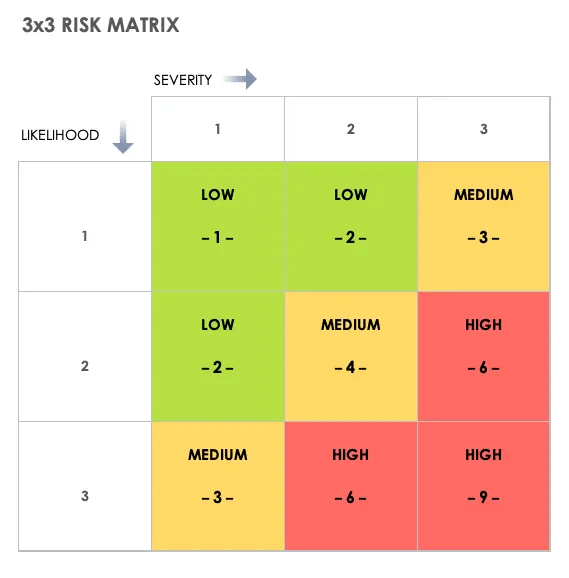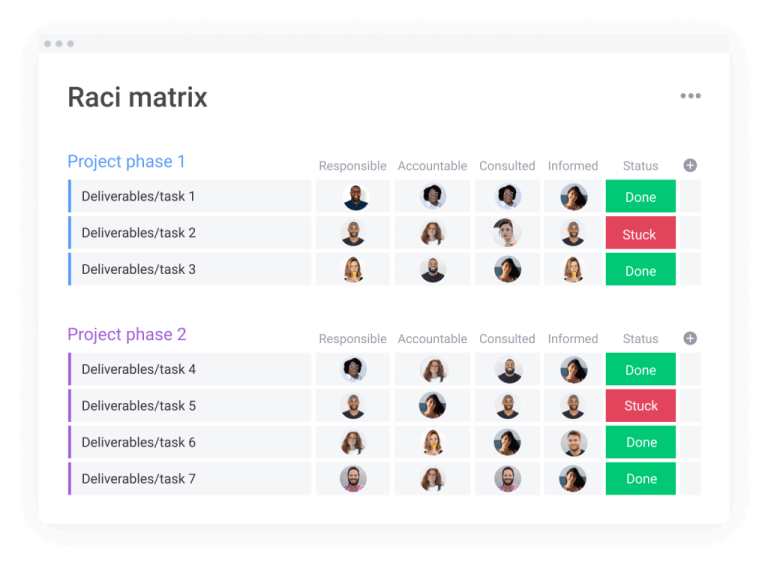A Responsibility Assignment Matrix (RAM) is a valuable tool for any business, no matter the size. It is a structured way to ensure that every aspect of a project is assigned to the correct person, thus ensuring that each person knows what is expected of them and helps to keep the project on track. To better navigate all this, opt for a reliable project management system. Such a tool can outline the roles, responsibilities, and processes to prevent potential issues. And that is why you need Responsibility Assignment Matrix (RAM).
This article will cover what RAM is, how it differs from RACI, its key advantages and disadvantages, why your business needs it, and how to create one. By taking the time to set up a RAM, your business will be able to operate more efficiently and effectively.
RAM vs RACI: What’s the Difference?
When it comes to managing a team, it’s important to know the difference between RACI and RAM. RACI stands for Responsible, Accountable, Consulted, and Informed, and RAM stands for Responsibility Assignment Matrix. While both models are useful for assigning roles and responsibilities when it comes to project management, there are subtle differences between the two that could have a big impact on your team’s success.
A Responsibility Assignment Matrix (RAM) is similar to the RACI model in that it helps to define and communicate roles and responsibilities within a project team. However, a RAM provides more detail by identifying the specific tasks or activities that need to be completed and the individuals or roles that are responsible for each task.
A RAM typically includes a matrix with tasks or activities listed along one axis and team members or roles listed along the other axis. Each intersection within the matrix is assigned a letter code that identifies the level of responsibility for that task or activity. For example, the letter codes might be R for Responsible, A for Accountable, C for Consulted, I for Informed, or other codes depending on the specific organization's needs.
While the RACI model and RAM are both used to clarify roles and responsibilities within a project team, a RAM provides more detailed information about the specific tasks and activities that need to be completed and who is responsible for them.
What is a Responsibility Assignment Matrix (RAM)?
Imagine you are working on a project with a group of people. There are many different tasks that need to be completed, and it can be confusing to know who is responsible for what. That's where the RAM comes in. It's a chart that lists all of the tasks involved in the project and the people or roles responsible for each task.
For example, let's say you are working on a website design project. The RAM might list all of the different pages on the website (home page, about page, contact page, etc.) and the people responsible for designing each page. It might also list other tasks, such as writing the website content or testing the website functionality, and the people responsible for those tasks.
Using a RAM, everyone on the project team knows exactly what they are responsible for and who they need to work with to complete the project successfully. It helps to avoid confusion, reduce mistakes, and ensure that everyone is working together effectively.
What Is a RACI Model?
Using the RACI Model, project teams can easily track who is responsible for which tasks and who should be consulted and informed about particular project activities. It also helps to ensure that no one person is overburdened with too many responsibilities.
Responsible
It is a team member who handles completing a task or delivering a project. They are responsible for ensuring that the work is completed and that the objectives are met.
Accountable
This is the person who is ultimately responsible for the success or failure of the project or task. They are the decision-makers who are responsible for ensuring that the work is completed to the required standard.
Consulted
This is the team member or group of employees who need to be consulted before a decision can be made or action taken. They have valuable insights and expertise that can help ensure the project's success.
Informed
This is the team member or group of employees who need to be kept informed of progress and any decisions made. They may not be directly involved in the project, but they need to be aware of what is happening.
The RACI model is often used in project management to ensure that everyone involved in a project understands their roles and responsibilities. By clearly defining who is responsible, accountable, consulted, and informed, the RACI model helps to ensure that projects are completed on time, within budget, and to the required standard.
What Are the Benefits of a RAM?
There are several benefits to using a Responsibility Assignment Matrix (RAM) in project management:
Clarifies roles and responsibilities
The RAM helps to define and communicate who is responsible for each task or activity in a project. This clarity reduces confusion and ensures that everyone knows what they are responsible for, which can lead to improved productivity and efficiency.
Improves accountability
The RAM assigns accountability to specific individuals or roles for each task or activity. This makes it easier to hold people accountable for their work and ensure that tasks are completed on time and to the required standard.
Facilitates teamwork
By clarifying who is responsible for each task, the RAM helps to promote teamwork and collaboration within the project team. It ensures that team members know who they need to work with to complete tasks and can communicate effectively with each other.
Helps to identify potential issues
By identifying who is responsible for each task or activity, the RAM can help to highlight potential issues or gaps in the project plan. This allows project managers to address these issues before they become significant problems.
Enhances project management
The RAM is a valuable tool for project managers as it helps to manage project risks, track progress, and monitor performance. It provides a clear project overview and ensures everyone is working towards the same goals.

RAM template in Smartsheet. Source: Smartsheet
Is RAM Right for My Business?
A Responsibility Assignment Matrix (RAM) can be beneficial to any type of business or organization that undertakes projects with multiple team members or departments involved.
- Information technology: IT projects often involve multiple team members with different areas of expertise, such as software development, database management, and network administration. Using a RAM can help to clarify roles and responsibilities, ensure effective communication between team members, and track progress.
- Construction: Construction projects involve many different tasks, from planning and design to construction and finishing. A RAM can help to ensure that everyone knows what they are responsible for, reduce mistakes, and improve overall project management.
- Marketing and advertising: Marketing and advertising campaigns often involve multiple team members working on different aspects of the campaign, such as creative design, copywriting, and media placement. A RAM can help to ensure that everyone is working together effectively and that the campaign is executed smoothly.
- Healthcare: Healthcare organizations often undertake complex projects, such as implementing new technology or improving patient care processes. A RAM can help to ensure that everyone knows their responsibilities, reduce errors, and improve patient outcomes.
What Is a RACI Chart?
The RACI chart is typically presented as a matrix with tasks or deliverables listed along one axis and team members or roles listed along the other axis. Each cell in the matrix is assigned one or more of the four roles to indicate who is responsible, accountable, consulted, or informed for that task or deliverable.
The RACI chart helps to clarify roles and responsibilities, improve communication, and reduce confusion or misunderstandings about who is responsible for what. It ensures that everyone on the project team knows what is expected of them and who they need to work with to complete the project successfully.

RACI Model. Source: Monday.com
When Should You Use a RACI Matrix and When You Shouldn’t?
A RACI chart can be a useful tool in project management, but it's not always necessary or appropriate to use.

Example of the RACI model in Monday.com. Source: Monday.com
Use a RACI matrix if you are dealing with:
- Project planning: A RACI matrix can be used during the planning phase of a project to ensure that everyone involved understands their roles and responsibilities. This helps to avoid confusion and ensures that tasks are completed efficiently.
- Process improvement: A RACI matrix can identify areas where there are overlaps or gaps in responsibilities within a process. This can help to streamline the process and improve efficiency.
- Cross-functional teams: A RACI matrix can be used when multiple teams or departments are involved in a project. This helps to ensure that everyone understands their role in the project and that there is no duplication of effort.
- Change management: A RACI matrix can be used during a change management process to ensure that all stakeholders know their roles and responsibilities during the change. This helps to ensure that the change is implemented smoothly and efficiently.
And a RACI matrix won’t serve you well if you work with or your team
- Simple projects: For very small and simple projects, a RACI chart may be overkill. In such cases, it may be more efficient to assign tasks and responsibilities as needed simply.
- Agile methodologies: In agile methodologies, teams are self-organizing and cross-functional, focusing on collaboration and flexibility. In such cases, a RACI chart may not be as useful, as the team members themselves are responsible for determining and carrying out their own tasks.
- Lack of clarity: If there is a lack of clarity around a project or process, a RACI chart may not be effective. This is because the chart relies on everyone understanding their roles and responsibilities. If there is confusion or ambiguity, the chart may only serve to create more confusion.
- Resistance to change: If there is significant resistance to change within a business, a RACI chart may not be effective. This is because the chart requires everyone to be on board and committed to their roles and responsibilities, and if there is resistance, the chart may be seen as an imposition rather than a helpful tool.
Example of RACI Matrix (and How to Use It)
A RACI matrix is a simple yet effective tool that can be used to clarify roles and responsibilities within a project or process. Here is an example of a RACI matrix and how to use it:
Example of RACI Matrix:
Task/Activity | Responsible | Accountable | Consulted | Informed |
| Develop project plan | Project Manager | Project Sponsor | Team Members | Stakeholders |
| Conduct market research | Marketing Team | Marketing Manager | Sales Team | Management |
| Write code | Developer | Technical Lead | Product Manager | QA Team |
| Create project budget | Finance Team | CFO | Project Manager | Team Members |
How to Use a RACI Matrix?
- List the tasks or activities: Begin by listing all the tasks or activities that need to be completed in the project or process.
- Identify the roles: Next, identify the roles or positions involved in the project or process. This may include individuals or teams.
- Assign RACI values: Assign a RACI value to each task or activity for each role or position involved.
- Review and adjust: Review the RACI matrix with all stakeholders involved in the project or process. Make any necessary adjustments to ensure that everyone agrees with the roles and responsibilities assigned.
- Use the RACI matrix: Once the RACI matrix is agreed upon, use it as a reference tool throughout the project or process to ensure that everyone understands their roles and responsibilities. The RACI matrix can help to avoid confusion, minimize duplication of effort, and improve overall efficiency.
What Are the Strong and Week Sides of RACI Matrix?
The pros of a RACI matrix include the following:
- clarifies roles and responsibilities
- improves accountability
- reduces duplication of effort
- enhances communication
Cons of a RACI matrix to know about are:
- time-consuming to create
- may not capture all nuances
- may not be suitable for every project
- can be difficult to make changes or adjustments without disrupting the overall structure.
Why Do You Need a RAM or a RAC?
RAM is a tool that focuses on defining and assigning specific roles and responsibilities to team members for each task or activity in a project or process. It helps to ensure that everyone knows what their responsibilities are and helps to avoid duplication of effort.
On the other hand, RACI is a tool that helps to define roles and responsibilities for each task or activity in terms of four categories: responsible, accountable, consulted, and informed. It helps to clarify who is responsible for the task, who is accountable for its completion, who should be consulted for input, and who should be informed of progress.
Both RAM and RACI have their own advantages and disadvantages, and the choice between the two depends on the specific needs of the project and the preferences of the project manager. However, it's worth noting that RACI is more commonly used in larger projects or organizations with complex structures, while RAM is more commonly used in smaller projects or organizations with simpler structures.
Ultimately, the choice between RAM and RACI depends on the specific needs of the project, the size of the team, and the complexity of the project or process. Both tools can be effective in clarifying roles and responsibilities and ensuring that projects are completed efficiently and effectively.
Want to migrate to the project management software?
Let's migrate PM data together!

